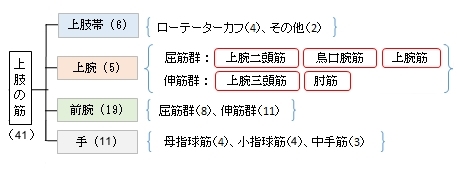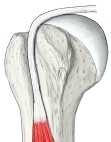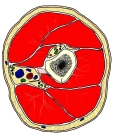上腕ニ頭筋 ( じょうわんにとうきん、英:biceps brachii muscle )
・ 概 要 |
・ 作 用 |
・ イラスト掲載サイト |
|
・ イラスト |
・ 神経 / 脈管 |
||
・ 起始 / 停止 |
・ Wikipedia |
![]()



共通の腱は接続して橈骨粗面に終わるが、一部は上腕ニ頭筋腱膜となって前腕筋膜まで及んでいる。
⇒ イラスト解説 ⇒ 長頭の停止腱の解説ページ
・「両頭が合して共通の筋腹を構成するのは三角筋の停止部付近となる」 (Wikipedia)
「Both heads of the biceps join in the middle upper arm to form a single muscle mass usually near the
insertion of the deltoid to form a common muscle belly」
ただ、「両頭の筋腹は全く別のものである」という報告も見られる。 (Wikipedia)
「 several anatomic studies have demonstrated that the muscle bellies remain distinct structures without
confluent fibers」

筋連結 : 浅指屈筋 ・円回内筋 ・烏口腕筋 ・橈側手根屈筋 ・長掌筋 ・深指屈筋
「日本人体解剖学」には以下のような解説文が見られる。
「 異常 : 長頭または短頭、あるいは前部を欠くこと、長・短頭がほとんど独立すること、長・短頭が
さらに分かれることがある。第3頭が肩甲骨、上腕骨などから起こることがある。」
⇒ 「Rauber-Kopsch解剖学」の上腕ニ頭筋の引用文のページ
![]()
 |
||||
![]()

|
![]()
「 長頭は前腕を外転し、短頭は前腕を内転する。上腕二頭筋が全体として働くときは前腕を屈曲し、回外する。 」 ( 日本人体解剖学 )
![]()
・ 神 経 : 筋皮神経 (C5, C6) ※ 資料によっては(C6, C7)
![]()
The biceps (Latin: musculus biceps brachii, "two-headed muscle of the arm", sometimes abbreviated to biceps brachii) is a large muscle that lies on the front of the upper arm between the shoulder and the elbow. Both heads of the muscle arise on the scapula and join to form a single muscle belly which is attached to the upper forearm. While the biceps crosses both the shoulder and elbow joints, its main function is at the elbow where it flexes the forearm and supinates the forearm. Both these movements are used when opening a bottle with a corkscrew: first biceps screws in the cork (supination), then it pulls the cork out (flexion).[2]
【 語 句 】
・ scapula : 肩甲骨 ・ muscle belly : 筋腹 ・ supinate : 回外する ・ corkscrew : コルク栓抜き
【 Structure 】
The biceps are one of three muscles in the anterior compartment of the upper arm, along with the brachialis muscle and the coracobrachialis muscle, with which the biceps shares a nerve supply.[1] The biceps muscle has two heads, the short head and the long head, distinguished according to their origin at the coracoid process and supraglenoid tubercle of the scapula, respectively.[1] From its origin on the glenoid, the long head remains tendinous as it passes through the shoulder joint and through the intertubercular groove of the humerus.[2] Extending from its origin on the coracoid, the tendon of the short head runs adjacent to the tendon of the coracobrachialis as the conjoint tendon. Unlike the other muscles in the anterior compartment of the arm, the biceps muscle crosses two joints, the shoulder joint and the elbow joint.
Both heads of the biceps join in the middle upper arm to form a single muscle mass usually near the insertion of the deltoid to form a common muscle belly, although several anatomic studies have demonstrated that the muscle bellies remain distinct structures without confluent fibers.[3][4] As the muscle extends distally, the two heads rotate 90 degrees externally before inserting onto the radial tuberosity. The short head inserts distally on the tuberosity while the long head inserts proximally closer to the apex of the tuberosity.[3] The bicipital aponeurosis, also called the lacertus fibrosus, is a thick fascial band that organizes close to the musculotendinous junction of the biceps and radiates over and inserts onto the ulnar part of the antebrachial fascia.[5]
The tendon that attaches to the radial tuberosity is partially or completely surrounded by a bursa, the bicipitoradial bursa, which ensures frictionless motion between the biceps tendon and the proximal radius during pronation and supination of the forearm.[6]
Two muscles lie underneath the biceps brachii. These are the coracobrachialis muscle, which like the biceps attaches to the coracoid process of the scapula, and the brachialis muscle which connects to the ulna and along the mid-shaft of the humerus. Besides those, the brachioradialis muscle is adjacent to the biceps and also inserts on the radius bone, though more distally.
【 語 句 】
・ brachialis muscle :上腕筋 ・ coracobrachialis muscle : 烏口腕筋 ・ distinguished : 顕著な、目立って ・ coracoid process : 烏口突起 ・ supraglenoid tubercle : 関節上結節 ・ intertubercular groove : 結節間溝 ・ humerus : 上腕骨 ・ adjacent : 近隣の ・ conjoint tendon : 結合腱 ・ distinct : 全く別の ・ confluent : 合流する ・ radial tuberosity : 橈骨粗面 ・ apex : 頂点 ・ bicipital aponeurosis : 上腕二頭筋腱膜 ・ antebrachial fascia : 前腕筋膜 ・ bursa : 滑液包 ・ bicipitoradial bursa : 二頭筋橈骨包? ・ ulna : 尺骨 ・ brachioradialis muscle : 腕橈骨筋
【 Variation 】
Traditionally described as a two-headed muscle, biceps brachii is one of the most variable muscles of the human body and has a third head arising from the humerus in 10% of cases (normal variation)—most commonly originating near the insertion of the coracobrachialis and joining the short head—but four, five, and even seven supernumerary heads have been reported in rare cases.
One study found a higher than expected number of female cadavers with a third head of biceps brachii, equal incidence between sides of the body, and uniform innervation by musculocutaneous nerve.
The distal biceps tendons are completely separated in 40% and bifurcated in 25% of cases.
【 Nerve supply 】
See also: Biceps reflex
The biceps shares its nerve supply with the other two muscles of the anterior compartment. The muscles are supplied by the musculocutaneous nerve. Fibers of the fifth, sixth and seventh cervical nerves make up the components of the musculocutaneous nerve which supply the biceps.
【 Blood supply 】
The blood supply of the biceps is the brachial artery. The distal tendon of the biceps can be useful for palpating the brachial pulse, as the artery runs medial to the tendon in the cubital fossa.
【 語 句 】
・variable : 変わりやすい ・ supernumerary : 規定数以上の ・ cadaver : 死体 ・ incidence : 発生率 ・ musculocutaneous nerve : 筋皮神経 ・ cervical nerves : 頚神経 ・ brachial artery : 上腕動脈 ・ palpate : 触診する ・ cubital fossa : 肘窩
【 Function 】
Flexed arm in the pronated position (left); with the biceps partially contracted and in a supinated position with the biceps more fully contracted, approaching minimum length (right.)
The biceps works across three joints. The most important of these functions is to supinate the forearm and flex the elbow. Besides, the long head of biceps prevents the upward displacement of the head of the humerus. In more detail, the actions are, by joint:
- Proximal radioulnar joint of the elbow – The biceps brachii functions as a powerful supinator of the forearm, i.e. it turns the palm upwards. This action, which is aided by the supinator muscle, requires the humeroulnar joint of the elbow to be at least partially flexed. If the humeroulnar joint, is fully extended, supination is then primarily carried out by the supinator muscle. The biceps is a particularly powerful supinator of the forearm due to the distal attachment of the muscle at the radial tuberosity, on the opposite side of the bone from the supinator muscle. When flexed, the biceps effectively pulls the radius back into its neutral supinated position in concert with the supinator muscle.:346–347
- Humeroulnar joint of the elbow – The biceps brachii also functions as an important flexor of the forearm, particularly when the forearm is supinated.[1] Functionally, this action is performed when lifting an object, such as a bag of groceries or when performing a biceps curl. When the forearm is in pronation (the palm faces the ground), the brachialis, brachioradialis, and supinator function to flex the forearm, with minimal contribution from the biceps brachii. It is also important to note that regardless of forearm position, (supinated, pronated, or neutral) the force exerted by the biceps brachii remains the same; however, the brachioradialis has a much greater change in exertion depending on position than the biceps during concentric contractions. That is, the biceps can only exert so much force, and as forearm position changes, other muscles must compensate.
- Glenohumeral joint (shoulder joint) – Several weaker functions occur at the glenohumeral joint. The biceps brachii weakly assists in forward flexion of the shoulder joint (bringing the arm forward and upwards). It may also contribute to abduction (bringing the arm out to the side) when the arm is externally (or laterally) rotated. The short head of the biceps brachii also assists with horizontal adduction (bringing the arm across the body) when the arm is internally (or medially) rotated. Finally, the short head of the biceps brachii, due to its attachment to the scapula (or shoulder blade), assists with stabilization of the shoulder joint when a heavy weight is carried in the arm. The tendon of the long head of the biceps also assists in holding the head of the humerus in the glenoid cavity.
【 語 句 】
・ pronated position : 回内位 ・ supinator muscle : 回外筋 ・ contracted : 収縮する ・ partially :部分的に ・ supinated position : 回外位 ・ Proximal radioulnar joint : 上橈尺骨関節 ・ humeroulnar joint : 腕尺関節 ・ palm : 手のひら ・ in concert with ~ : ~ と共同して ・ pronation : 回内(運動) ・ contribution : 寄与 ・ exertion : 行使 ・ concentric : 同中心の ・ compensate : 補う ・ glenoid cavity : 肩甲上腕関節 (=肩関節) ・ be attributed ~ : ~と考えられている
![]()












